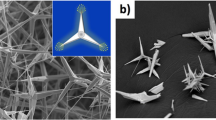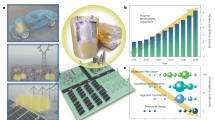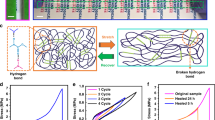Abstract
High-voltage power transmission in electrical grids requires reliable and durable dielectric polymers for wire insulation1,2. Electrical treeing caused by high, local electric fields is a damaging process that leads to structure degradation and electrical conduction of dielectric materials, and ultimately, to catastrophic failure of the devices3,4,5. Here, we demonstrate that the addition of less than 0.1 volume per cent of superparamagnetic nanoparticles into a thermoplastic polymer enables the repair of regions damaged by electrical treeing and the restoration of the insulating properties. Under the application of an oscillating magnetic field, the embedded nanoparticles migrate to the electrical trees and generate a higher local temperature, which heals the electrical tree channels in the polymer. Our method allows us to regenerate the dielectric strength and electrical resistivity over multiple cycles of tree formation and healing, which could be used to increase the lifespan and sustainability of power cables for electronics and energy applications.
This is a preview of subscription content, access via your institution
Access options
Access Nature and 54 other Nature Portfolio journals
Get Nature+, our best-value online-access subscription
$29.99 / 30 days
cancel any time
Subscribe to this journal
Receive 12 print issues and online access
$259.00 per year
only $21.58 per issue
Buy this article
- Purchase on Springer Link
- Instant access to full article PDF
Prices may be subject to local taxes which are calculated during checkout




Similar content being viewed by others
Data availability
The data that support the plots within this paper and other findings of this study are available from the corresponding authors upon reasonable request.
References
Dissado, L. A. & Fothergill, J. C. Electrical Degradation and Breakdown in Polymers (IET, London, 1992).
Tanaka, T., Okamoto, T., Nakanishi, K. & Miyamoto, T. Aging and related phenomena in modern electric-power systems. IEEE Trans. Electr. Insul. 28, 826–844 (1993).
Bamji, S. S., Bulinski, A. T., Chen, Y. & Densley, R. J. Threshold voltage for electrical tree inception in underground HV transmission cables. IEEE Trans. Electr. Insul. 27, 402–404 (1992).
Shimizu, N. & Laurent, C. Electrical tree initiation. IEEE Trans. Electr. Insul. 5, 651–659 (1998).
Dissado, L. A., Dodd, S. J., Champion, J. V., Williams, P. I. & Alison, J. M. Propagation of electrical tree structures in solid polymeric insulation. IEEE Trans. Dielect. Electr. Insul. 4, 259–279 (1997).
Jarvid, M. et al. A new application area for fullerenes: voltage stabilizers for power cable insulation. Adv. Mater. 27, 897–902 (2015).
Cherney, E. A. Nanodielectrics applications—today and tomorrow. IEEE Electr. Insul. Mag. 29, 59–65 (2013).
Salvatierra, L. M. et al. Self-healing during electrical treeing: a feature of the two-phase liquid–solid nature of silicone gels. IEEE Trans. Dielect. Electr. Insul. 23, 757–767 (2016).
Patrick, J. F., Robb, M. J., Sottos, N. R., Moore, J. S. & White, S. R. Polymers with autonomous life-cycle control. Nature 540, 363–370 (2016).
Blaiszik, B. J. et al. Self-healing polymers and composites. Annu. Rev. Mater. Res. 40, 179–211 (2010).
Xing, L. et al. Self-healable polymer nanocomposites capable of simultaneously recovering multiple functionalities. Adv. Funct. Mater. 26, 3524 (2016).
Chen, Y., Kushner, A. M., Williams, G. A. & Guan, Z. Multiphase design of autonomic self-healing thermoplastic elastomers. Nat. Chem. 4, 467–472 (2012).
Chen, X. et al. A thermally re-mendable cross-linked polymeric material. Science 295, 1698–1702 (2002).
Cordier, P., Tournilhac, F., Soulié-Ziakovic, C. & Leibler, L. Self-healing and thermoreversible rubber from supramolecular assembly. Nature 451, 977–980 (2008).
Burnworth, M. et al. Optically healable supramolecular polymers. Nature 472, 334–337 (2011).
White, S. R. et al. Autonomic healing of polymer composites. Nature 409, 794–797 (2001).
Toohey, K. S., Sottos, N. R., Lewis, J. A., Moore, J. S. & White, S. R. Self-healing materials with microvascular networks. Nat. Mater. 6, 581–585 (2007).
White, S. R. et al. Restoration of large damage volumes in polymers. Science 344, 620–623 (2014).
Li, J. Y., Zhang, L. & Ducharme, S. Electric energy density of dielectric nanocomposites. Appl. Phys. Lett. 90, 132901 (2007).
Corten, C. C. & Urban, M. W. Repairing polymers using oscillating magnetic field. Adv. Mater. 21, 5011–5015 (2009).
Yoonessi, M. et al. Self-healing of core-shell magnetic polystyrene nanocomposites. ACS Appl. Mater. Interfaces 7, 16932–16937 (2015).
Ahmed, A. S. & Ramanujan, R. V. Magnetic field triggered multicycle damage sensing and self healing. Sci. Rep. 5, 13773 (2015).
Gupta, S., Zhang, Q., Emrick, T., Balazs, A. C. & Russell, T. P. Entropy-driven segregation of nanoparticles to cracks in multilayered composite polymer structures. Nat. Mater. 5, 229–233 (2006).
Lee, J. Y., Buxton, G. A. & Balazs, A. C. Using nanoparticles to create self-healing composites. J. Chem. Phys. 121, 5531–5540 (2004).
Balazs, A. C., Emrick, T. & Russell, T. P. Nanoparticle polymer composites: where two small worlds meet. Science 314, 1107–1110 (2006).
Fortin, J. et al. Size-sorted anionic iron oxide nanomagnets as colloidal mediators for magnetic hyperthermia. J. Am. Chem. Soc. 129, 2628–2635 (2007).
Kim, Y. H. & Wool, R. P. A theory of healing at a polymer–polymer interface. Macromolecules 16, 1115–1120 (1983).
Stone, G. C. Partial discharge diagnostics and electrical equipment insulation condition assessment. IEEE Trans. Electr. Insul. 12, 891–904 (2005).
Kim, H. et al. Coil design and measurements of automotive magnetic resonant wireless charging system for high-efficiency and low magnetic field leakage. IEEE Trans. Microw. Theory 2, 383–400 (2016).
Schneider, P. E., Horio, M. & Lorenz, R. D. Evaluation of point field sensing in IGBT modules for high-bandwidth current measurement. IEEE Trans. Ind. Appl. 49, 1430–1437 (2013).
Acknowledgements
This work was supported by the Program of National Key Basis and Development Plan (973) (grant 2014CB239505 to J. He). The scanning transmission electron microscopy was performed in Beijing Neurosurgical Institute (China). The authors thank C.J. Cao (Carl Zeiss Co. Ltd, Shanghai, China) for sample mounting method and imaging technology support in the computed micro-X-ray tomography tests, and Z.X. Cao (Object Research Systems Inc., Montreal, Canada) for assistance with 3D reconstruction and analysis.
Author information
Authors and Affiliations
Contributions
J. He, Q.L., Q.W. and Y.Y. conceived and designed the experiments. Y.Y., Q.L., L.G. and J. Hu carried out the experiments. Y.Y. and J.Q. performed simulations. Y.Y., J. He, Q.L., R.Z., Q.W. and S.X.W. analysed the data. Q.L., Q.W. and J.He wrote the manuscript. All authors discussed the results and commented on the manuscript.
Corresponding authors
Ethics declarations
Competing interests
The authors declare no competing interests.
Additional information
Publisher’s note: Springer Nature remains neutral with regard to jurisdictional claims in published maps and institutional affiliations.
Supplementary information
Supplementary Information
Supplementary Figures 1–19 Supplementary Table 1–7
Rights and permissions
About this article
Cite this article
Yang, Y., He, J., Li, Q. et al. Self-healing of electrical damage in polymers using superparamagnetic nanoparticles. Nature Nanotech 14, 151–155 (2019). https://doi.org/10.1038/s41565-018-0327-4
Published:
Issue Date:
DOI: https://doi.org/10.1038/s41565-018-0327-4
This article is cited by
-
Autonomous indication of electrical degradation in polymers
Nature Materials (2024)
-
Particle Distribution Informed by Chain Rigidity in Diblock Copolymer Melts: The Effect of Entropy
Chinese Journal of Polymer Science (2024)
-
Recent progress of dielectric polymer composites for bionics
Science China Materials (2023)
-
Mechanical response model with core loss of microcapsules under uniaxial compression and its parameters analysis
Archive of Applied Mechanics (2023)
-
Self-healable printed magnetic field sensors using alternating magnetic fields
Nature Communications (2022)



